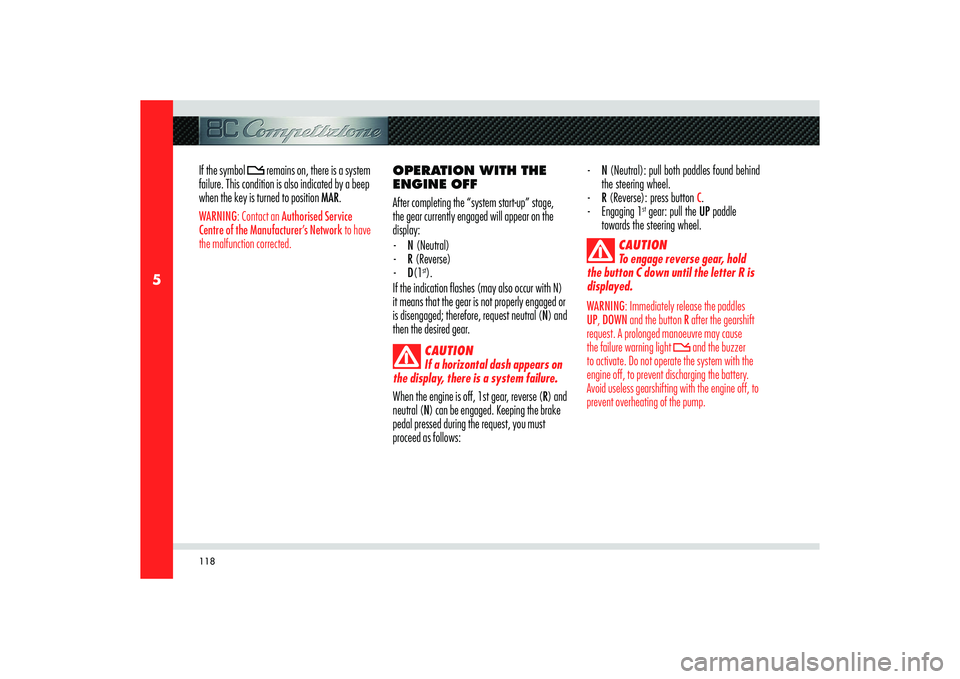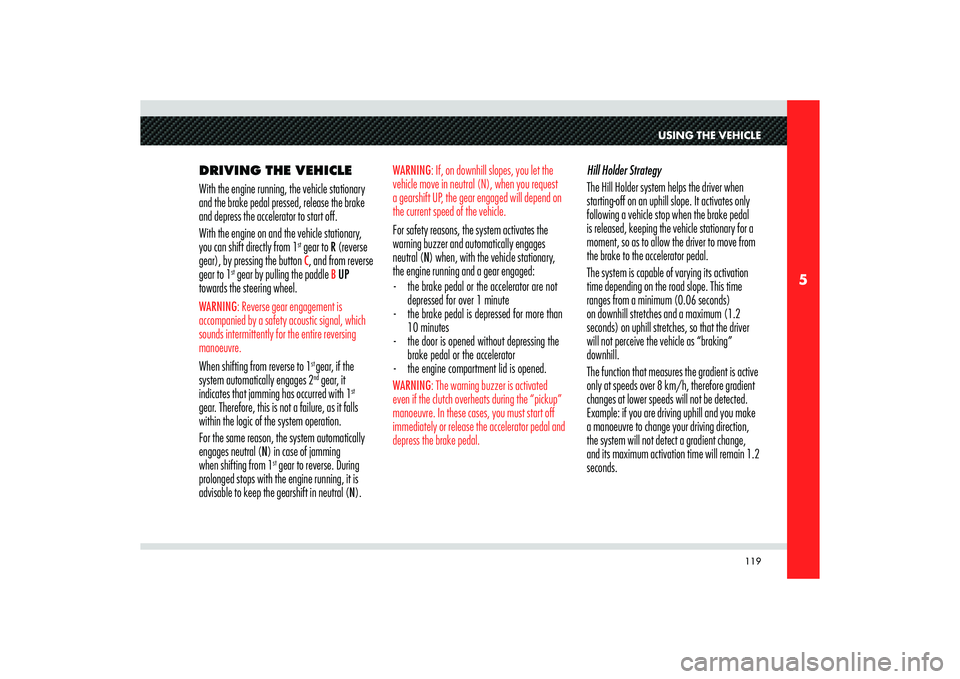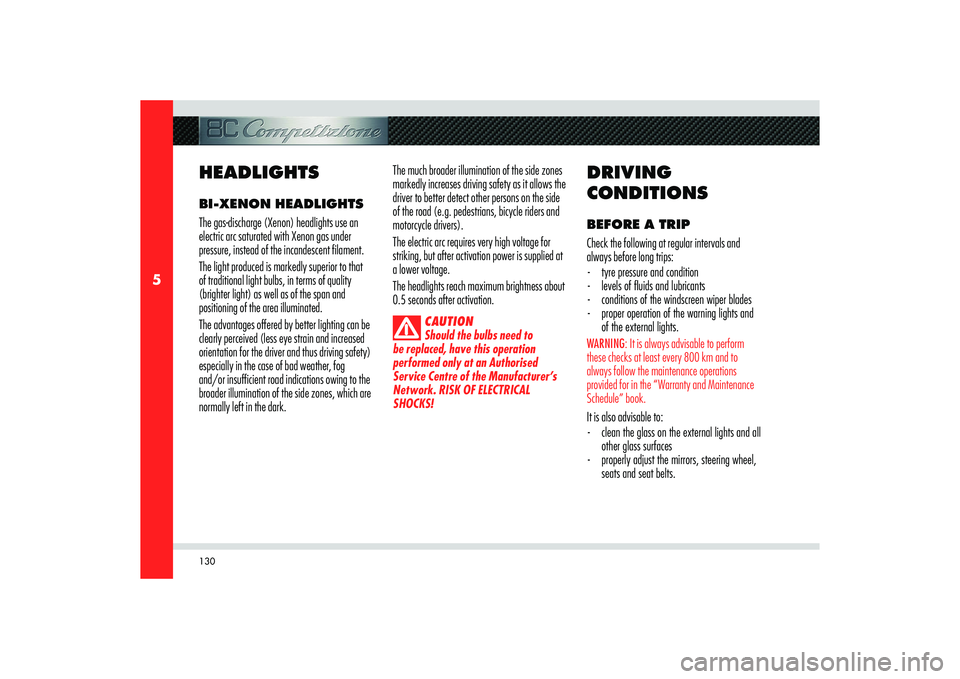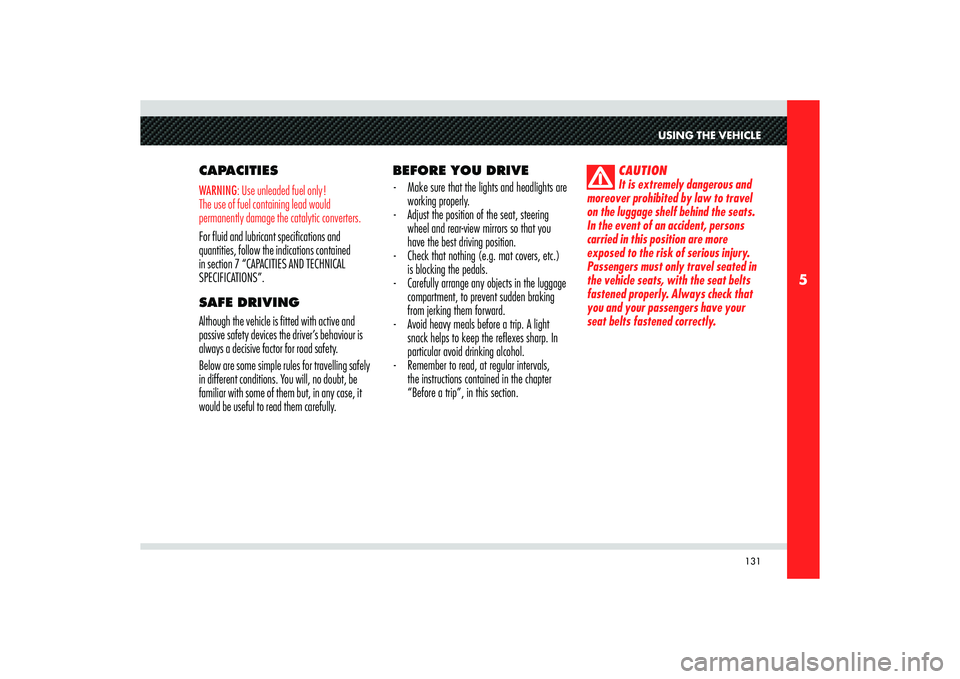wheel Alfa Romeo 8C 2010 Owner handbook (in English)
[x] Cancel search | Manufacturer: ALFA ROMEO, Model Year: 2010, Model line: 8C, Model: Alfa Romeo 8C 2010Pages: 223, PDF Size: 14.35 MB
Page 120 of 223

118
5
If the symbol
remains on, there is a system
failure. This condition is also indicated by a beep
when the key is turned to position MAR.
WARNING: Contact an Authorised Service
Centre of the Manufacturer’s Network to have
the malfunction corrected.
OPERATION WITH THE
ENGINE OFF
After completing the “system start-up” stage,
the gear currently engaged will appear on the
display:
- N (Neutral)
- R (Reverse)
- D(1
st).
If the indication flashes (may also occur with N)
it means that the gear is not properly engaged or
is disengaged; therefore, request neutral (N) and
then the desired gear.CAUTION
If a horizontal dash appears on
the display, there is a system failure.
When the engine is off, 1st gear, reverse (R) and
neutral (N) can be engaged. Keeping the brake
pedal pressed during the request, you must
proceed as follows:
- N (Neutral): pull both paddles found behind
the steering wheel.
- R (Reverse): press button
C.
- Engaging 1
st gear: pull the UP paddle
towards the steering wheel.
CAUTION
To engage reverse gear, hold
the button C down until the letter R is
displayed.
WARNING: Immediately release the paddles
UP, DOWN and the button R after the gearshift
request. A prolonged manoeuvre may cause
the failure warning light
and the buzzer
to activate. Do not operate the system with the
engine off, to prevent discharging the battery.
Avoid useless gearshifting with the engine off, to
prevent overheating of the pump.
Page 121 of 223

119
5
USING THE VEHICLE
DRIVING THE VEHICLE
With the engine running, the vehicle stationary
and the brake pedal pressed, release the brake
and depress the accelerator to start off.
With the engine on and the vehicle stationary,
you can shift directly from 1
st gear to R (reverse
gear), by pressing the button C, and from reverse
gear to 1
st gear by pulling the paddle
B UP
towards the steering wheel.
WARNING: Reverse gear engagement is
accompanied by a safety acoustic signal, which
sounds intermittently for the entire reversing
manoeuvre. When shifting from reverse to 1
st gear, if the
system automatically engages 2nd gear, it
indicates that jamming has occurred with 1
st
gear. Therefore, this is not a failure, as it falls
within the logic of the system operation.
For the same reason, the system automatically
engages neutral (N) in case of jamming
when shifting from 1
st gear to reverse. During
prolonged stops with the engine running, it is
advisable to keep the gearshift in neutral (N).Hill Holder Strategy
The Hill Holder system helps the driver when
starting-off on an uphill slope. It activates only
following a vehicle stop when the brake pedal
is released, keeping the vehicle stationary for a
moment, so as to allow the driver to move from
the brake to the accelerator pedal.
The system is capable of varying its activation
time depending on the road slope. This time
ranges from a minimum (0.06 seconds)
on downhill stretches and a maximum (1.2
seconds) on uphill stretches, so that the driver
will not perceive the vehicle as “braking”
downhill.
The function that measures the gradient is active
only at speeds over 8 km/h, therefore gradient
changes at lower speeds will not be detected.
Example: if you are driving uphill and you make
a manoeuvre to change your driving direction,
the system will not detect a gradient change,
and its maximum activation time will remain 1.2
seconds.
WARNING: If, on downhill slopes, you let the
vehicle move in neutral (N), when you request
a gearshift UP, the gear engaged will depend on
the current speed of the vehicle. For safety reasons, the system activates the
warning buzzer and automatically engages
neutral (N) when, with the vehicle stationary,
the engine running and a gear engaged:
- the brake pedal or the accelerator are not
depressed for over 1 minute
- the brake pedal is depressed for more than
10 minutes
- the door is opened without depressing the
brake pedal or the accelerator
- the engine compartment lid is opened.WARNING: The warning buzzer is activated
even if the clutch overheats during the “pickup”
manoeuvre. In these cases, you must start off
immediately or release the accelerator pedal and
depress the brake pedal.
Page 123 of 223

121
5
USING THE VEHICLE
REQUESTING
NEUTRAL (N)
If necessary, neutral (N) can be requested at any
speed.
If you then operate the UP paddle, the system
will engage a gear suited to the vehicle speed.
STOPPING THE VEHICLE
When the vehicle stops, the system
automatically engages 1
st gear (unless N has
already bee requested).
With the vehicle stationary and the engine
running, hold the brake pedal depressed until
you are ready to start off again. TURNING OFF
THE ENGINE AND
DEACTIVATING THE
SYSTEM
The engine can only be turned off with the
gearbox in 1
st, or reverse gear R.
If the gear is in neutral and the key is turned
from MAR to position STOP, the display remains
on for a few seconds showing the letter (N)
flashing and activating the acoustic signal.
For safety reasons, to avoid undesired and
sudden vehicle movements:
CAUTION
Never leave the vehicle with
the gear in neutral (N), but engage
1
st or reverse gear and check that the
parking brake has been engaged. Do
not leave the vehicle with the engine
running.CAUTION
Do not remove the key when
the vehicle is moving! The system (and
thus the display) would remain active
but malfunctioning, until the vehicle
stops; in addition, the steering wheel
would lock automatically at the first
turn of the wheel.
In this case, the failure symbol
will
illuminate and, before starting-off again, the
system must be turned off and the “system start-
up” phase repeated.
In any event, it is best to:
- Turn off the engine and the system holding
the brake pedal depressed.
- Do not request a gearshift while the system
is turning off.
Page 125 of 223

123
5
F
USING THE VEHICLE
“SPORT” mode
It is activated by pressing button
F; the letter “S”
will illuminate on the display.
To return to “NORMAL” mode from “SPORT”
mode, press the button again.
As “SPORT” mode has lower priority over “low-
grip” and “automatic gearshift” modes, if these
are already active when you activate “SPORT”
mode, the system will ignore the command even
though the relative warning light switches on.
CAUTION
“SPORT” mode is characterised
by faster gearshifts than in
“NORMAL” mode and engine power
reduction through the ASR system is
kept to a minimum.
Fast gearshifting however always depends on
the accelerator pedal travel and on the engine
RPM, as in “NORMAL” mode.
DOWNshifts with the accelerator pedal released,
will have a braking effect approaching the
skidding of the driving wheels on dry asphalt.
Under racing-style driving conditions with
gearshifts at high engine RPM, double-clutching
when up-shifting is performed automatically.
CAUTION
It is advisable not to use
“SPORT” mode on roads with low or
medium “grip” conditions (e.g. ice,
snow, or wet roads) as the driving
wheels could skid during gearshifts.
Therefore, excessive use of the vehicle
in “SPORT” mode is advisable only on
racetracks.
If you use a racing-style driving when starting-off
or gearshifting with SPORT mode active, you
might feel the driving wheels begin to slip even
on dry roads.
It is a good rule to deactivate the other operating
modes (“low-grip” and “automatic gearshift”)
before you select “SPORT” mode.
Page 126 of 223

124
5
WARNING: In the event that the control lever
assembly is malfunctioning, in addition to
activating the buzzer and the failure warning
light
, the system enables “automatic
gearshift” mode and any gearshift command,
including the request for N and R, will be
ignored.
WARNING: If the malfunction persists,
contact an Authorised Service Centre of the
Manufacturer’s Network as soon as possible to
have the malfunction corrected.
PUSH START
In the case of malfunctioning of the starter
system, you can push-start the vehicle
proceeding as follows
- perform the “system start-up” stage
- request UP while the vehicle is picking up
speed with the gearbox in N.WARNING: This procedure should not be used
unless there is an emergency situation!
USING THE
BRAKESTo allow the brake pads and discs to run in
properly, avoid sudden braking during the first
300 km.
The ABS is a component of the braking system
that provides two basic advantages:
- It avoids locking of the wheels and thus
skidding during emergency braking,
especially under low grip conditions.
- It makes it possible to brake and steer at
the same time in order to avoid unexpected
obstacles or to direct the vehicle where
desired when braking: this is in keeping
with the physical limits of the tyre side grip. In order to fully exploit the ABS:
- You will note a light vibration of the brake
pedal during emergency braking or braking
under low grip conditions: This indicates
that the ABS is operating. Do not release
the pedal but continue to press it to give
continuity to the braking action.
- The ABS prevents the wheels from locking,
but it does not increase the physical grip
limits between the tyres and the road.
So, even with vehicles equipped with
ABS, always ensure that you keep to a
safe distance from the vehicle in front and
reduce your speed when entering a bend.
Page 132 of 223

130
5
HEADLIGHTSBI-XENON HEADLIGHTS
The gas-discharge (Xenon) headlights use an
electric arc saturated with Xenon gas under
pressure, instead of the incandescent filament.
The light produced is markedly superior to that
of traditional light bulbs, in terms of quality
(brighter light) as well as of the span and
positioning of the area illuminated.
The advantages offered by better lighting can be
clearly perceived (less eye strain and increased
orientation for the driver and thus driving safety)
especially in the case of bad weather, fog
and/or insufficient road indications owing to the
broader illumination of the side zones, which are
normally left in the dark.The much broader illumination of the side zones
markedly increases driving safety as it allows the
driver to better detect other persons on the side
of the road (e.g. pedestrians, bicycle riders and
motorcycle drivers).
The electric arc requires very high voltage for
striking, but after activation power is supplied at
a lower voltage.
The headlights reach maximum brightness about
0.5 seconds after activation.
CAUTION
Should the bulbs need to
be replaced, have this operation
performed only at an Authorised
Service Centre of the Manufacturer’s
Network. RISK OF ELECTRICAL
SHOCKS!
DRIVING
CONDITIONSBEFORE A TRIP
Check the following at regular intervals and
always before long trips:
- tyre pressure and condition
- levels of fl uids and lubricants
- conditions of the windscreen wiper blades
- proper operation of the warning lights and
of the external lights.WARNING: It is always advisable to perform
these checks at least every 800 km and to
always follow the maintenance operations
provided for in the “Warranty and Maintenance
Schedule” book.It is also advisable to:
- clean the glass on the external lights and all
other glass surfaces
- properly adjust the mirrors, steering wheel,
seats and seat belts.
Page 133 of 223

131
5
USING THE VEHICLE
CAPACITIESWARNING: Use unleaded fuel only!
The use of fuel containing lead would
permanently damage the catalytic converters.For fluid and lubricant specifications and
quantities, follow the indications contained
in section 7 “CAPACITIES AND TECHNICAL
SPECIFICATIONS”.
SAFE DRIVING
Although the vehicle is fitted with active and
passive safety devices the driver’s behaviour is
always a decisive factor for road safety.
Below are some simple rules for travelling safely
in different conditions. You will, no doubt, be
familiar with some of them but, in any case, it
would be useful to read them carefully.BEFORE YOU DRIVE
- Make sure that the lights and headlights are
working properly.
- Adjust the position of the seat, steering
wheel and rear-view mirrors so that you
have the best driving position.
- Check that nothing (e.g. mat covers, etc.)
is blocking the pedals.
- Carefully arrange any objects in the luggage
compartment, to prevent sudden braking
from jerking them forward.
- Avoid heavy meals before a trip. A light
snack helps to keep the refl exes sharp. In
particular avoid drinking alcohol.
- Remember to read, at regular intervals,
the instructions contained in the chapter
“Before a trip”, in this section.
CAUTION
It is extremely dangerous and
moreover prohibited by law to travel
on the luggage shelf behind the seats.
In the event of an accident, persons
carried in this position are more
exposed to the risk of serious injury.
Passengers must only travel seated in
the vehicle seats, with the seat belts
fastened properly. Always check that
you and your passengers have your
seat belts fastened correctly.
Page 135 of 223

133
5
USING THE VEHICLE
- Use the high beams only outside of urban
areas and when you are sure that they will
not disturb other drivers.
- When another vehicle is approaching,
switch the high beams (if on) to low
beams.
- Keep the lights and headlights clean.
- Outside urban areas, beware of animals
crossing the road. DRIVING IN THE RAIN
Rain and wet roads are dangerous. On a wet
road all the manoeuvres are more difficult since
wheel grip on the asphalt is significantly reduced.
This means that the braking distances increase
considerably and the road holding decreases.
Certain advice for driving in the rain follows:
- Reduce your speed and keep a greater
safety distance from the vehicles in front
of you. High speed may result in a loss of
control and aquaplaning.
- Heavy rain also substantially reduces
visibility.
- Set the Air Conditioning controls to
demisting, in order to avoid any visibility
problems.
- Periodically check the conditions of the
windscreen wiper blades. DRIVING IN FOG
If the fog is dense avoid travelling where
possible.
When driving in mist, blanket fog or when there
is the possibility of banks of fog:
- Keep a moderate speed.
- Turn on the rear fog lights. Do not use the
main beam.
- Remember that fog creates dampness on
the asphalt and thus any type of manoeuvre
is more diffi cult and braking distances are
greater.
- Keep a safe distance from the vehicle in
front of you.
- Avoid sudden changes in speed as much as
possible.
- Whenever possible, avoid passing other
vehicles.
- If you are forced to stop the vehicle
(breakdowns, impossibility of proceeding
due to poor visibility, etc.), fi rst of all, try to
stop off of the travel lane. Then turn on the
hazard warning lights and if possible, the
low beams.
Page 138 of 223

136
5
OTHER ADVICE
- Do not warm up the engine when the
vehicle is stationary: in these conditions
the engine heats up much more slowly and
increases fuel consumption and emissions.
It is much better to move off slowly,
avoiding high engine RPM.
- As soon as traffi c conditions and the route
permit it, use a higher gear.
- Avoid depressing the accelerator repeatedly
during stops at traffi c lights or before
turning off the engine.
- Keep your speed as regular as possible,
avoiding unnecessary brake applications
and accelerations, which cause fuel wastage
and strongly increase exhaust emissions.
- Turn the engine off if the vehicle remains
stationary for a long time. - Check the tyre pressure regularly: if the
pressure is too low, fuel consumption
increases and the tyres are damaged.
- Do not transport unnecessary objects in
the luggage compartment. The weight
of the vehicle affects fuel consumption
considerably.
- Use the electrical devices only as long as
necessary. The power required increases
fuel consumption.
PARKINGPull the electric parking brake, straighten the
wheels and turn off the engine.
Never leave the ignition key in position MAR.
Always remove the key when getting out of the
vehicle.
CAUTION
Never leave children
unattended in the vehicle.
CAUTION
Do not park the vehicle on
paper, grass, dry leaves or other
flammable materials. They could catch
fire if they come into contact with hot
parts of the exhaust system.
CAUTION
Do not leave the engine running
with the vehicle unattended.
Page 143 of 223

141
5
USING THE VEHICLE
TYRESTYRE INFLATION
PRESSURE WHEN COLD
The tyre inflating ratings shown in this manual
must be read as values applicable with cold
tyres.
CAUTION
When winter tyres are fitted,
it is advisable not to exceed a speed
of 220 km/h. Always observe the
regulations in force in the country
where you are driving and follow
the instructions provided by the tyre
manufacturer.
CAUTION
When using the spare wheel
(emergency wheel) do not exceed 80
km/h. Avoid driving at full throttle,
braking sharply and cornering at high
speeds.
WINTER TYRES
These tyres are specially designed for driving on
snow and ice and are fitted to replace the ones
supplied with the vehicle.
CAUTION
Only use winter tyres having
the same dimensions as those provided
with the vehicle or as indicated on
page 186.
The Authorised Service Centres of the
Manufacturer’s Network are available to
provide suggestions as to the types of tyres most
suited to the use foreseen by the Customer.
For the type of tyres to use, inflation pressures
and relative specifications for winter tyres,
carefully follow the indications found in the
section “Capacities and technical specifications”.
The features of these tyres are markedly reduced
in winter when tread depth is less than 4 mm. In
this case, they should be replaced.The specific features of the winter tyres lead to
lower performance under normal environmental
conditions or on long highway trips, compared to
the standard tyres.
Therefore, they should only be fitted for
their intended use, for which they have been
approved.
CAUTION
Fit identical (manufacturer and
tread) tyres on all four wheels, in
order to ensure safe driving, braking
and good manoeuvrability.
CAUTION
Remember that the direction of
tyre rotation should not be reversed.